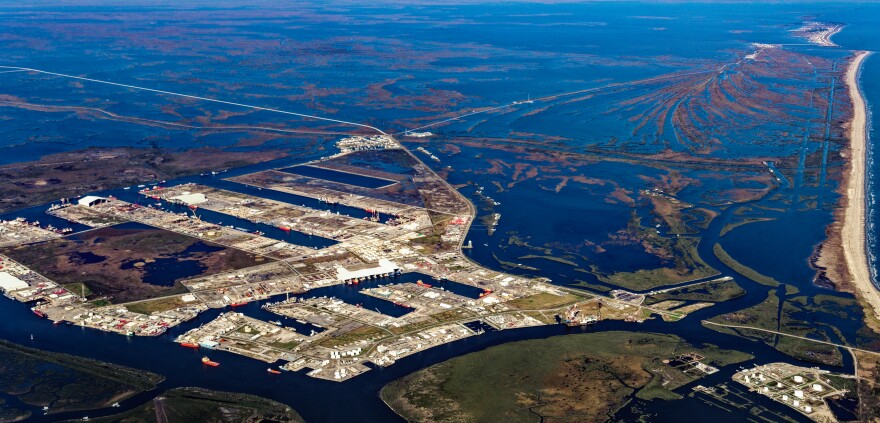Gathered on a strip of salt marsh bordering the Gulf of Mexico, Tim Carruthers and his team of scientists huddle around a patch of soil marked by protruding PVC pipes.
Pelicans soar overhead and massive ocean-going ships cruise by, heading toward the neighboring oil and gas seaport of Port Fourchon. But Carruthers’ team has their eyes fixed on the ground.
The group works a thick pipe into the soft dirt and releases liquid nitrogen, letting it flow into the ground with a loud hiss. The process results in a long tube of frozen mud — a sample they can take back to the lab.
“What we like to call a sediment popsicle,” said Carruthers, director of coastal ecology at the Water Institute of the Gulf.
The sediment popsicle is at the center of his research into something hard to see — carbon dioxide.

Carruthers’ research is part of an effort to understand how big a role Louisiana marshes can play in the fight against climate change. The larger the role, the more money they could be worth.
Marshes can act as "carbon sinks," or natural spaces that absorb and store more carbon than they release. In fact, coastal wetlands are among the best habitats on Earth at sequestering carbon. Louisiana is rich in them.
The state holds almost two-thirds of all the carbon stored in coastal marshes along the Gulf Coast. The reason is twofold: Louisiana has far more wetlands than its Gulf neighbors and its soil accumulates carbon at a faster rate.
Louisiana marshes’ knack for capturing carbon could allow the state to eventually create a new market for carbon credits, where companies invest in the restoration of coastal ecosystems as a way to offset their greenhouse gas emissions.
Carruthers said the arrangement presents the chance for a “triple win:” reducing planet-warming emissions, enhancing knowledge of marshes and creating a new way to fund coastal restoration.
“All of these efforts are trying to see if we can get to a point that it's financially viable,” he said.
But the carbon equation for this dynamic habitat is complicated.
Depending on how salty the marsh is, methane-burping bacteria in the soil can thrive, negating some of the carbon stored by marsh grasses and mangroves. The bacteria is less tolerant to salty water, but Carruthers said the salinity of Louisiana marshes can vary widely.
“There are just some uncertainties,” he said. “So we have to make very conservative assumptions.”
The constant flux makes it hard to estimate a marsh’s capacity to store carbon. So far, Carruthers said that’s made selling carbon credits for marshes financially inviable.
Based on current models, Carruthers said a marsh-building project covering almost 3,500 acres would only offer up to $1 million in return over 30 years. To put that into perspective, the state’s largest marsh restoration project — the Upper Barataria Marsh Creation project — was a third of that size and cost $181 million to build.
Even still, the state and companies continue to be enthusiastic about the market’s potential.
Carruthers’ research is in partnership with Chevron, which owns the strip of land outside of Port Fourchon that hosts his study site.
Chevron environmental geoscientist Cas Bridge said the research presents an exciting opportunity to look into nature-based climate solutions.
“I think there's this acknowledgment that there's going to be this sort of an amount of emissions that are hard or impossible to abate, and so that's where offsets come in,” she said.

Even if carbon credits aren’t in the cards, Bridges said the study is also a way to look at the potential for habitat restoration to increase Port Fourchon’s resiliency against rising sea levels and storms that have grown stronger due to climate change. In a way, a carbon market would be a bonus.
“There is an element of playing the long game,” she said. “And nothing in the research so far indicates that we should stop.”
Isabel Englehart, a policy advisor for the Governor’s Office of Coastal Activities, said there has always been uncertainty around how large of a role marshes can play.
She said Carruthers’ research sheds light on one of the state’s most valuable resources. But the extent to which marshes may play a role in the state’s plan to reach carbon neutrality by 2050 is still a question mark.
“Natural sequestration is not going to be the silver bullet for reducing our statewide emissions,” Englehart said. “But it could be a big part of it.”




